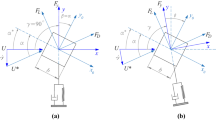Abstract
Galloping is a type of aeroelastic instability characterized by large amplitude, low frequency, normal to wind oscillations. It normally appears in bodies with small stiffness and structural damping when they are placed in a flow and the incident velocity is high enough. In this paper a systematic approach for the analysis of galloping of triangular cross-section bodies is reported. Wind tunnel experiments have been conducted aiming at establishing the unstable characteristics of isosceles triangular cross-section bodies when subjected to a uniform flow with angles of attack ranging from 0 to 180°. The results have been summarized in a stability map, where galloping instability zones in the angle of attack—main vertex angle plane—are identified.








Similar content being viewed by others
References
Alonso G, Meseguer J (2005) A parametric study of the galloping stability of triangular cross-section bodies. J Wind Eng Ind Aerodyn (submitted)
Chabart O, Lilien JL (1998) Galloping of electrical lines in wind tunnel facilities. J Wind Eng Ind Aerodyn 74–76:967–976
Courchesne J, Laneville A (1982) An experimental evaluation of drag coefficient of rectangular cylinders exposed to grid turbulence. J Fluid Eng 104:523–528
Hémon P, Santi F (2002) On the aeroelastic behaviour of rectangular cylinders in cross-flow. J Fluid Struct 16:855–889
Hémon P, Santi F, Schnoerringer B, Wojciechowski J (2001) Influence of free stream turbulence on the movement-induced vibrations of an elongated rectangular cylinder in cross flow. J Wind Eng Ind Aerodyn 89:1383–1395
Kawai H (1998) Effect of corner modifications on aeroelastic instabilities of tall buildings. J Wind Eng Ind Aerodyn 74–76:719–729
Kazakewich MI, Vasilenko AG (1996) Closed analytical solution for galloping aeroelastic self-oscillations. J Wind Eng Ind Aerodyn 65:353–360
Li QS, Fang JQ, Geary AP (1998) Evaluation of 2D coupled galloping oscillations of slender structures. Comput Struct 6:513–523
Luo SC, Chew YT, Lee TS, Yazdani MG (1998) Stability to translational galloping vibration of cylinders at different mean angles of attack. J Sound Vib 215:1183–1194
Luo SC, Chew YT, Ng YT (2003) Hysteresis phenomenon in the galloping oscillation of a square cylinder. J Fluid Struct 18:103–118
McComber P, Paradis A (1998) A cable galloping model for thin ice accretions. Atmos Res 46:13–25
Novak M (1969) Aeroelastic galloping of prismatic bodies. J Eng Mech Div Proc ASCE 9:115–142
Novak M (1972) Galloping oscillations of prismatic structures. J Eng Mech Div Proc ASCE 98:27–46
Parkinson G, Smith J (1964) The square cylinder as an aeroelastic non-linear oscillator. Q J Mech Appl Math 17:225–239
Ruecheweyh H, Hortmanns M, Schnakenberg C (1996) Vortex-excited vibrations and galloping of slender elements. J Wind Eng Ind Aerodyn 65:347–352
Simiu E, Scanlan RH (1996) Wind effects on structures. Fundamentals and applications to design. Wiley, New York
Suzuki M, Tanemoto K, Maeda T (2003) Aerodynamic characteristics of train/vehicles under cross winds. J Wind Eng Ind Aerodyn 91:209–218
Tamura T (1999) Reliability on CFD estimations for wind-structure interaction problems. J Wind Eng Ind Aerodyn 81:117–143
Tamura T, Itoh Y (1999) Unstable aerodynamic phenomena of a rectangular cylinder with critical section. J Wind Eng Ind Aerodyn 83:121–133
Torenbeek E (1976) Synthesis of subsonic airplane design. Delft University Press, Delft
Van Oudheusden BW (1994) On the quasi-steady analysis of one-degree-of freedom galloping with combined translational and rotational effects. Nonlinear Dyn 8:435–451
Van Oudheusden BW (1996) Aerodynamic stiffness effects in rotational galloping at high wind speeds. J Wind Eng Ind Aerodyn 64:31–46
Zdravkovich MM, Carelas E (1997) Aerodynamics of a covered pedestrian bridge of a trapezoidal section. J Wind Eng Ind Aerodyn 66:141–153
Ziller C, Ruscheweyh H (1997) A new approach for determining the onset velocity of galloping instability taking into account the nonlinearity of the aerodynamic damping characteristic. J Wind Eng Ind Aerodyn 69–71:303–314
Acknowledgements
The authors thank J. Fernández, V. Pinilla, J.M. Rey and G. Vidal for their helpful contribution in performing the experiments. The authors also thank the reviewers of this paper for their valuable comments.
Author information
Authors and Affiliations
Corresponding author
Rights and permissions
About this article
Cite this article
Alonso, G., Meseguer, J. & Pérez-Grande, I. Galloping instabilities of two-dimensional triangular cross-section bodies. Exp Fluids 38, 789–795 (2005). https://doi.org/10.1007/s00348-005-0974-8
Received:
Revised:
Accepted:
Published:
Issue Date:
DOI: https://doi.org/10.1007/s00348-005-0974-8




